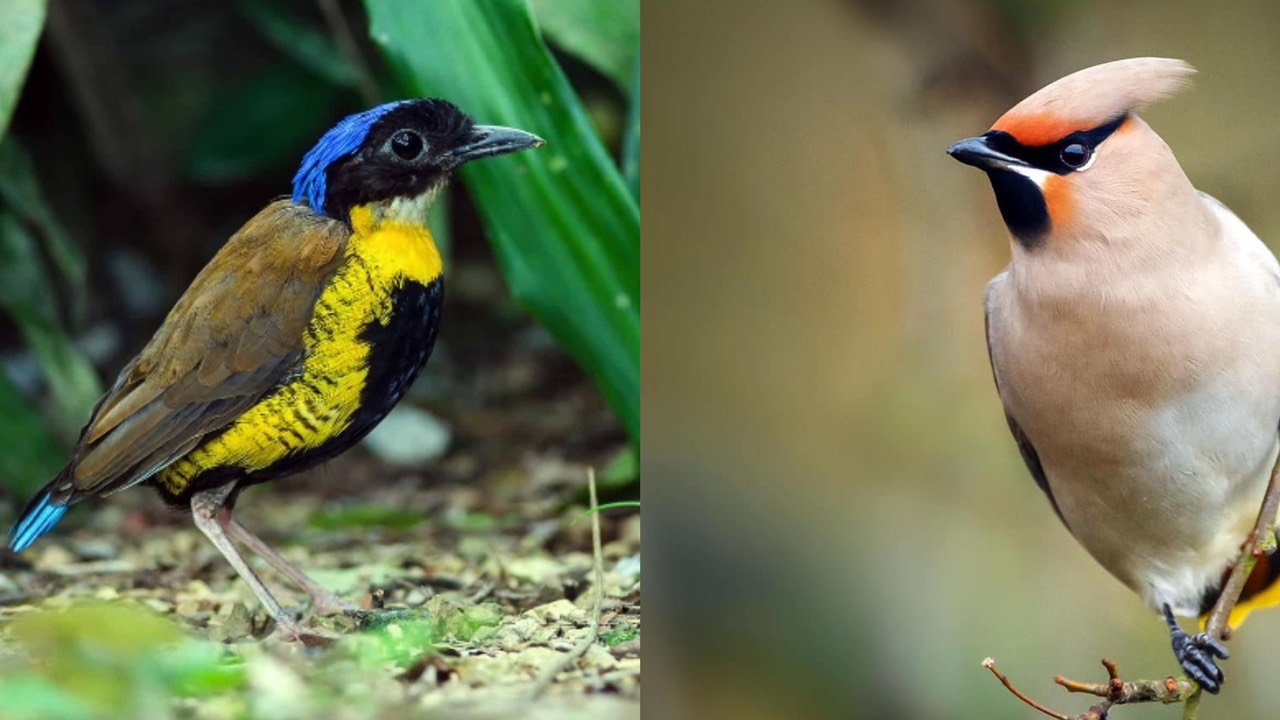
Looking for some gorgeous birds to amaze you? You are in the right place!
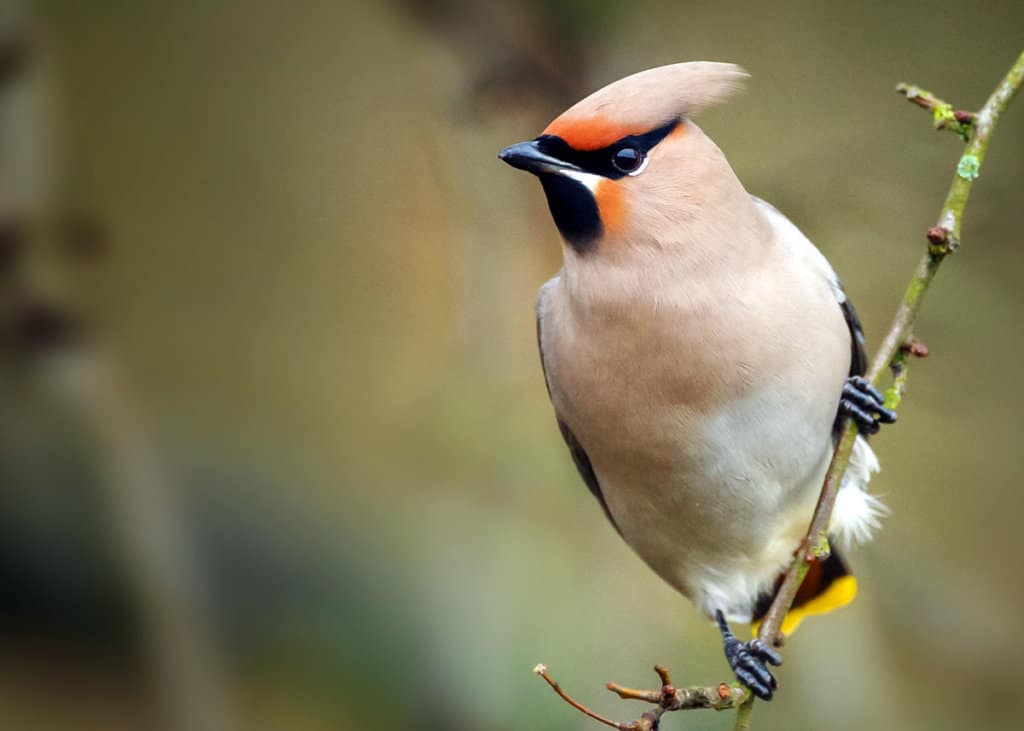
The world is filled with so many beautiful bird species, check out our top 15 picks for the most beautiful birds in the world.
15 of the Most Beautiful Birds in the World
Have you ever noticed how beautiful birds can change your whole perspective? You can be having a bad day, but if a pretty bird comes into view, you suddenly feel a little lighter.
1. Gurney’s Pitta
- Latin name: Hydrornis gurneyi
- Unique beautiful feature: Deep blue crown
- Where they are found: Myanmar and Thailand
- Size: Length: 8.25 inches (21 cm); Weight: 2 to 3 ounces (57 to 86 g)
- Diet: Insects, earthworms, and slugs
The Gurney’s pitta is a rare beauty indeed. If you hope to ever see one, you’ll need to travel to Khao Nor Chuchi in Thailand or Tenasserim, Myanmar, where the only remaining populations still exist.
One of the world’s most endangered bird species, this little pitta’s habitat of low-lying rainforest is quickly being cleared to make way for the palm oil industry.
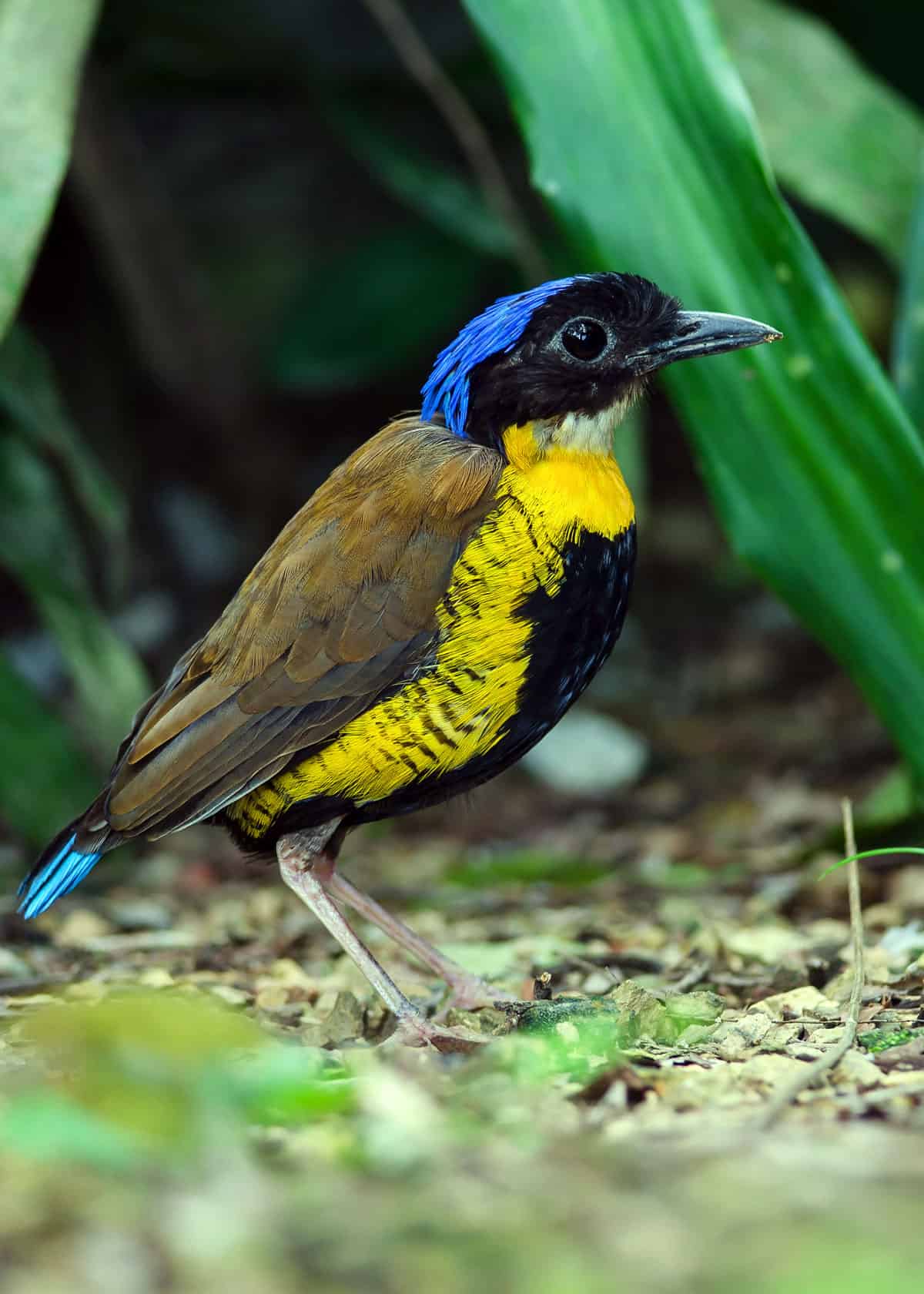
Gurney’s pittas like staying low to the ground, foraging for worms, insects, and slugs.
You wouldn’t have any trouble spotting the male with his distinctive turquoise crown and tail which contrast with its black and yellow underparts.
Donning a less dramatic blue tail, the female wears a brown crown and buffy-yellow underparts with dark barring.
Monogamous pairs make their nests on the ground or in Salacca palms during the wet season where the female incubates three to five eggs.
After the chicks hatch, the male provides food for both the female and the chicks. Sadly, due to this species’ low breeding success rate, only one chick from each clutch usually survives.
2. Bohemian Waxwing
- Latin name: Bombycilla garrulus
- Unique beautiful feature: Red and yellow feather tips and soft coloring
- Where they are found: North America and Eurasia
- Size: Length: 7.5 to 9.1 inches (19 to 23 cm); Weight: 1.9 ounces (55 g); Wingspan: 12.6 to 14 inches (32 to 35.5 cm)
- Diet: Insects and fruit
The flicker of red and yellow waxy feather tips on this songbird’s wings and tail will easily catch your eye, but it’s the buff plumage, pointed crest, and peach and black face markings that enhance the regal beauty of the Bohemian waxwing.
Living up to its name, this species is an unconventional wanderer that’s always on the move in search of fruit throughout North America and Eurasia. Unlike other songbirds, it is not territorial and has no true song of its own.
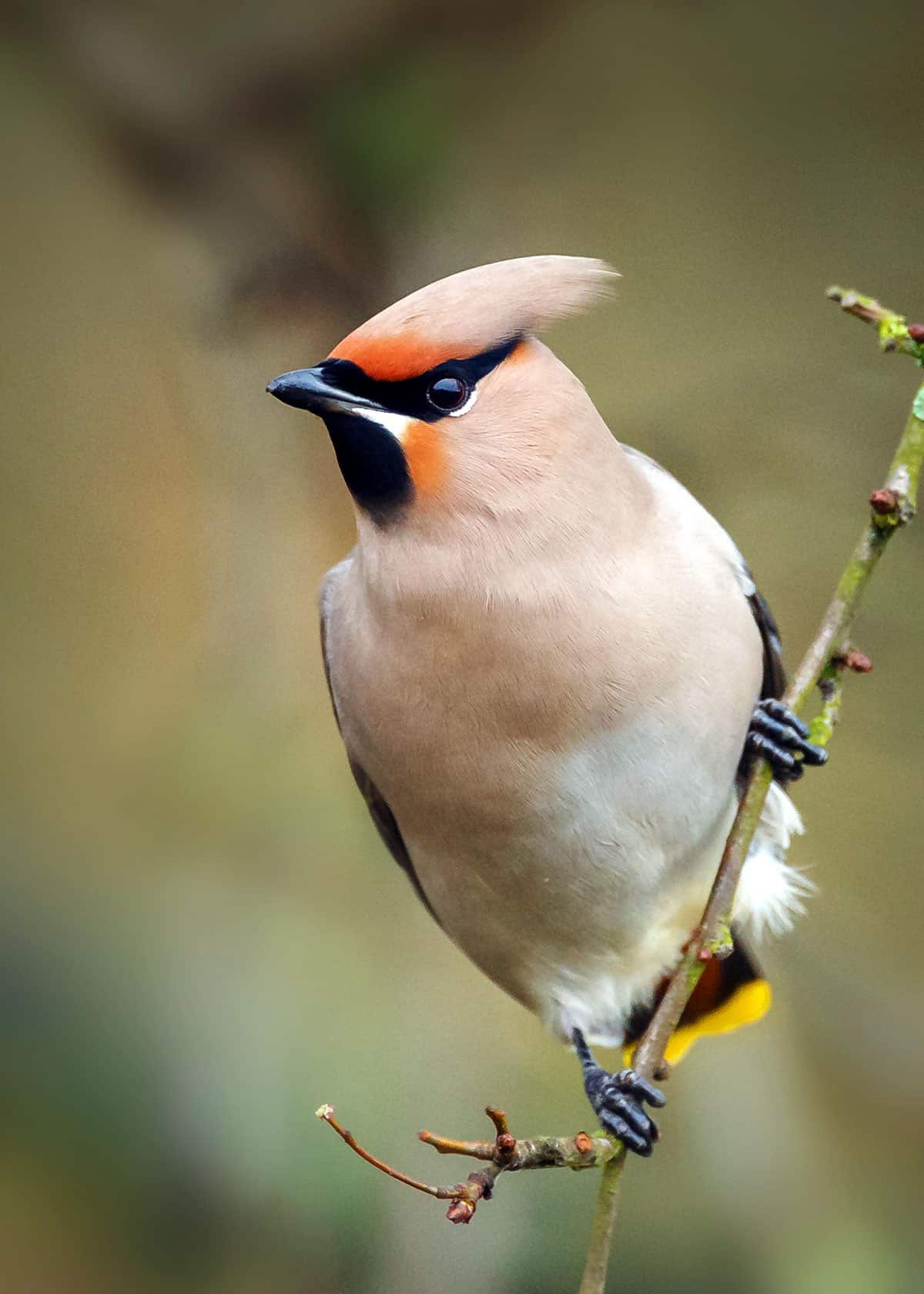
While Bohemian waxwings like to breed in evergreen forests nearby water, they will make stops anywhere during the non-breeding season where fruit abounds.
So you’re likely to see them in urban areas and parks. Or, you may attract them to your backyard by growing fruit-bearing trees and shrubs.
This species forms monogamous pairs only for the breeding season. The male courts the female by raising his crest, lowering his tail, and fluffing up his body feathers.
Once the female decides she is interested, both she and the male will exchange food offerings several times before mating.
Both males and females gather plant fibers such as grass, moss, and evergreen twigs to weave a cup-shaped nest where they will raise their clutch of two to six chicks.
3. Dusky Lory
- Latin name: Pseudeos fuscata
- Unique beautiful feature: Black and firey plumage
- Where they are found: New Guinea and Indonesia
- Size: Length: 10 inches (25 cm); Weight: 5 to 6.7 ounces (140 to 190 g)
- Diet: Flowers, pollen, nectar, fruits, and seeds
If the lovely sight of this fiery-colored parrot doesn’t make you sit up and smile, you should have your eyes checked.
The exact colors of this short-tailed lory species depend on which color phase you are viewing – the band running across the abdomen and chest are either orange or yellow.
Other features include a black-barred upper chest, white rump, blue tail, orange beak, red irises, and wings that vary in hues of black, brown and dark olive. Both males and females are identical.
These beautiful birds are found among the rainforests and blossoming trees of New Guinea and the surrounding islands of Yapen, Batanta, and Salawati where they feed on fruit, flowers, seeds, and nectar.
Intelligent, noisy, playful, and monogamous, dusky lories usually breed two to three eggs per clutch.
4. Blue Bird-of-Paradise
- Latin name: Paradisaea rudolphi
- Unique beautiful feature: Bright blue wings, back, and tail
- Where they are found: New Guinea
- Size: Length: 11 inches (30 cm); Weight: 5.57 to 6.66 ounces (158 to 189 g)
- Diet: Fruit, insects, and lizards
Considered by some bird experts to be one of the most beautiful birds, the blue bird-of-paradise is certainly a lovely sight to behold.
In contrast to a black head, chest, and back, the male sports a bright blue tail, a bluish-ivory bill, and white-ringed eyes. Reddish-brown flank plumes and two, long streaming tail feathers complete this dandy’s gorgeous garb.
The lady blue bird-of-paradise doesn’t possess the ornamental tail feathers but is similar to the male in colors except for her chestnut underparts.
Found in the forest canopy of New Guinea, these pretty birds go all out for their courtship performances.
The polygamous male puts on a solitary show for an attending female by hanging upside down from a tree branch, swaying back and forth, and spreading out his plumes and tail feathers while serenading with a humming call.
After mating, the male goes off to impress another lady while the female gets busy with breeding her one to three chicks.
5. African Crowned Crane
- Latin name: Balearica regulorum
- Unique beautiful feature: Golden starburst crest
- Where they are found: Eastern and Southern Africa
- Size: Height: 3.3 feet (1 m); Weight: 7.7 pounds (3.5 kg); Wingspan: 6.6 feet (2.01 m)
- Diet: Plants, seeds, insects, worms, snakes, frogs, and small fish
Also known as the grey-crowned crane, the African crowned crane stands tall and noble, decked out with an imperial-looking dress uniform that begins with his spiky, golden crest, poofy black forehead, and white cheeks.
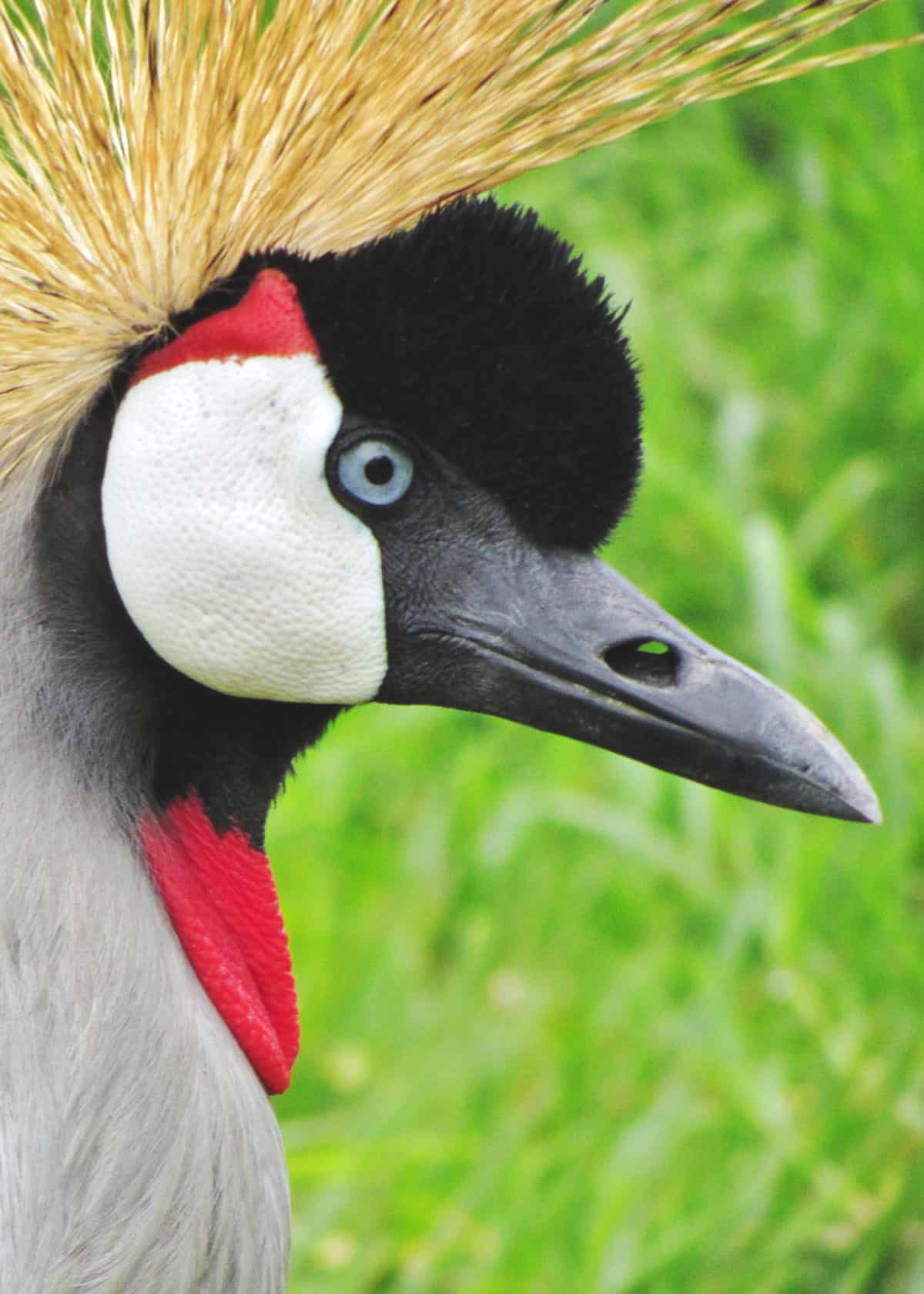
The long, elegant neck and red throat pouch extend to a cape of long, wispy gray feathers. The wide wingspan displays in patterns of black, chestnut, and golden colors.
Finishing off this stunning look are the slender, black legs. Both males and females look the same, but the male is usually a little larger.
Found in pairs or among small flocks along the wetlands and grasslands of eastern sub-Saharan Africa and South Africa, this elegant crane stomps its feet as it walks to stir up insects when it’s not munching on plants or taking fish, snakes, or frogs for dinner.
Like other cranes, this species also perform an elaborate courtship dance that involves wing-flapping, head-bobbing, and deep bows.
These monogamous cranes like to time their breeding habits so that all their chicks hatch at the same time, and their average clutch size of two to three eggs is the largest of any crane species.
6. Greater Bird of Paradise
- Latin name: Paradisaea apoda
- Unique beautiful feature: Long yellow flank plumes
- Where they are found: New Guinea and Aru Islands, Indonesia
- Size: Length: 17 inches excluding tail (43 cm); Weight:
- Diet: Fruits, seeds, and insects
Did you know that back in the 18th century, Europeans believed the greater bird-of-paradise species had no feet and never touched the earth? This is where these birds got their Latin name which means “legless bird-of-paradise.”
The reason for this misconception was that the feet were removed from the first specimens sent to Europe.
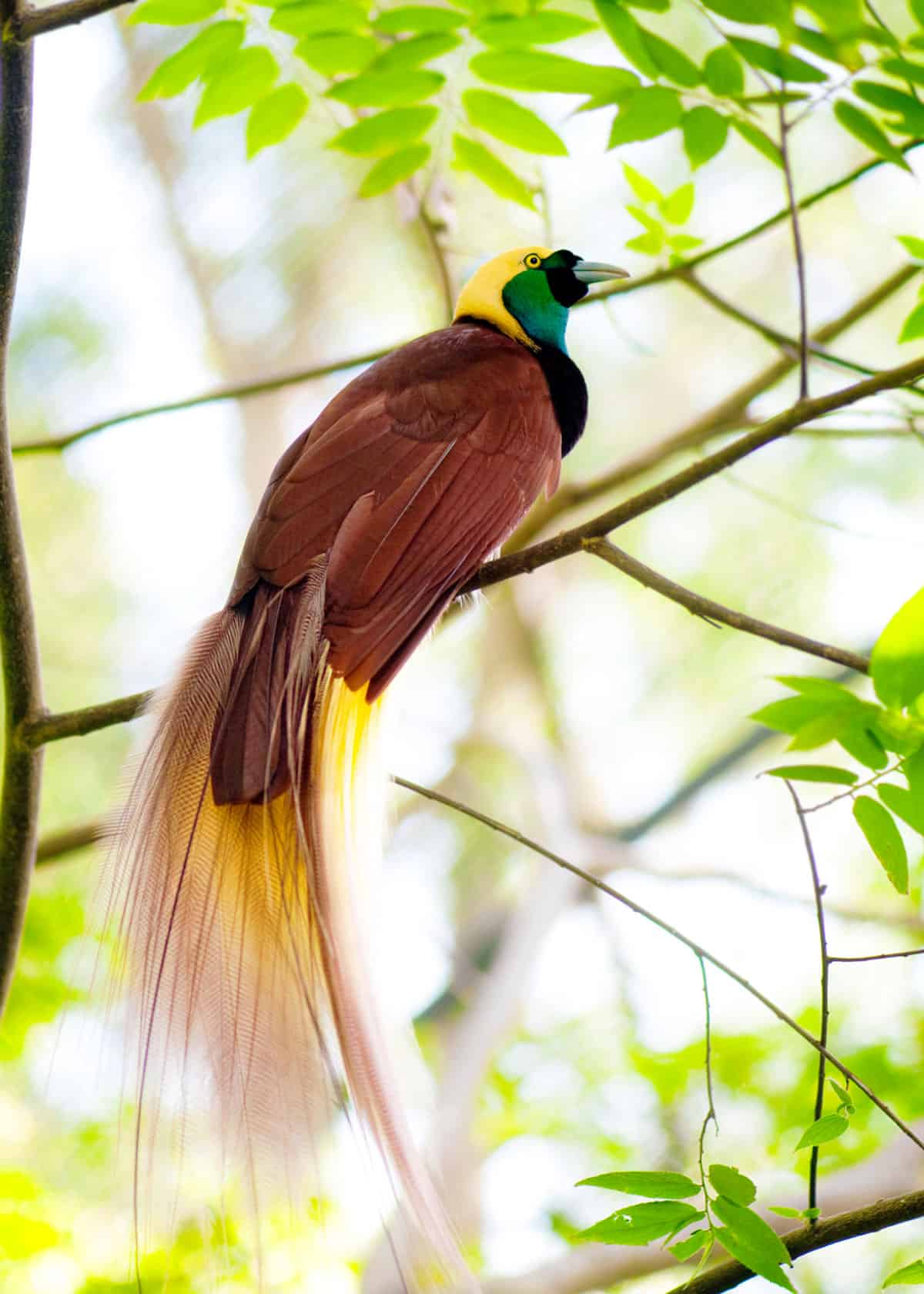
With his emerald green throat, yellow crown, blue beak, maroon-brown plumage, and long, billowing flank plumes of yellow and white, the male makes a spectacular sight.
Lacking the ornamental flank plumes, the female features mostly unbarred maroon-brown feathers.
Flying like colorful angels through the hill forests of the Aru Islands of Indonesia and New Guinea, these birds wake the dawn with their resounding “wawk-wawk” call as they go about searching for fruit, seeds, and insects.
These birds may be beautiful, but they do lack a certain… finesse. The below may be my favorite video of David Attenborough – staring the greater bird of paradise.
Male greater birds of paradise are polygamous and attract females through fancy courtship displays that consist of wing-flapping, bill-wiping, leaf-tearing, prancing, and swinging upside down from a tree branch with their tail plumes erected.
After choosing a male and mating, the female will raise an average clutch of three chicks by herself.
7. Superb Lyrebird
- Latin name: Menura novaehollandiae
- Unique beautiful feature: Elaborate, lyre-shaped tail
- Where they are found: Southern and Eastern Australia, Tasmania
- Size: Length: 30 to 39 inches (76 to 100 cm); Weight: 2.2 pounds (1 kg)
- Diet: Worms, spiders, and insects
The male superb lyrebird would be an ordinary pheasant if it weren’t for his ornate tail feathers that resemble the stringed musical instrument known as a lyre.
This makes a striking difference in his otherwise drab appearance that features a gray upper and lower body with reddish-brown wings and long, dark legs.
The signature tail boasts seven long pairs of lacy white feathers that are guarded on each side by a barred buff feather.
These two outer feathers are curved, and when raised, make the shape of a lyre. The male uses his extravagant tail to attract females by lifting it up and over his head in a silvery-white canopy.
Scratching through leaf litter for insects, worms, and spiders in the damp forests of eastern and southern Australia, the superb lyrebird is known for its excellent talent of mimicking anything it hears, whether that be the calls of other birds, dog barks or machinery noise.
While the male mates with various females, the female will visit several males before deciding to mate. She then will raise her single chick by herself in a domed nest of ferns and moss.
8. Cuban Tody
- Latin name: Todus multicolor
- Unique beautiful feature: Multicolored plumage
- Where they are found: Cuba and outlying islands
- Size: Length: 3.9 to 4.3 inches (11 cm); Weight: 0.151 to 0.299 ounces (4.3 to 8.5 g)
- Diet: Insects, fruits, spiders, and lizards
The little Cuban tody is so pretty and colorful that it looks like it popped out of a Kinder Surprise.
Commonly found in Cuba and surrounding smaller islands, this tody is so small that it could fit in the palm of your hand.
As its Latin name suggests, it is a multicolored bird with a vibrant green head, wings and tail, white underparts, pink flanks, a red throat, and blue patches on each side of the neck.
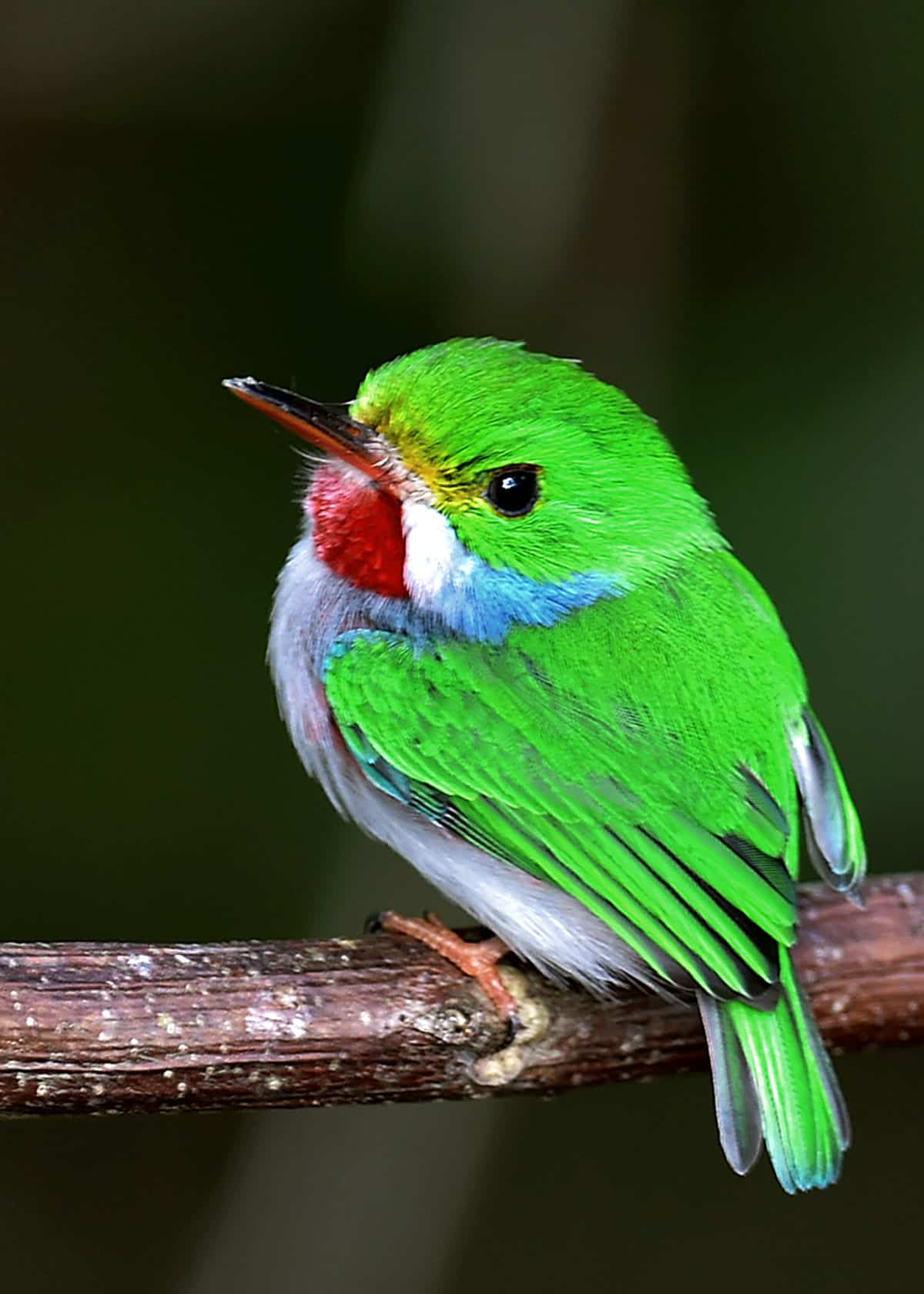
The bird’s broad, flat bill is red on the bottom and black on top. Both males and females look alike.
Often seen in pairs, this species loves to live in thickets, woodlands, and evergreen forests nearby streams and waters where its multicolors blend in with local flowers.
When perched, this tody repeats a “tot-tot-tot” sound, but its unique call is a musical “pprreeee-pprreeee.” In flight, this bird’s wings make a loud whirring noise.
These monogamous birds love to chase each other in flight during courtship displays and offer food to one another. At the height of the mating ritual, their pink flanks will fluff up and fully inflate.
After mating, both males and females will incubate and feed three to four chicks in a nest that’s been constructed in a tree hollow or embankment tunnel.
9. Secretary Bird
- Latin name: Sagittarius serpentarius
- Unique beautiful feature:
- Where they are found: Sub-Saharan Africa
- Size: Height: 4.3 feet (1.3 m); Avg. Weight: 8.9 pounds (4.02 kg); Wingspan: 75 to 87 inches (191 to 220 cm)
- Diet: Insects, small mammals and birds, lizards, snakes, and bird eggs
You may wonder why in the world this bird is called a secretary bird. It’s believed that this bird of prey got its English name during the 1800s when male European secretaries often wore gray tailcoat suits with dark knee-length breeches and goose-quill pens behind their ears.
When you look at the secretary bird, you can see how this name fits perfectly.
The bird’s gray/white upper body and tail resemble a tailcoat suit while the dark, lower feathers look like the knee breeches.
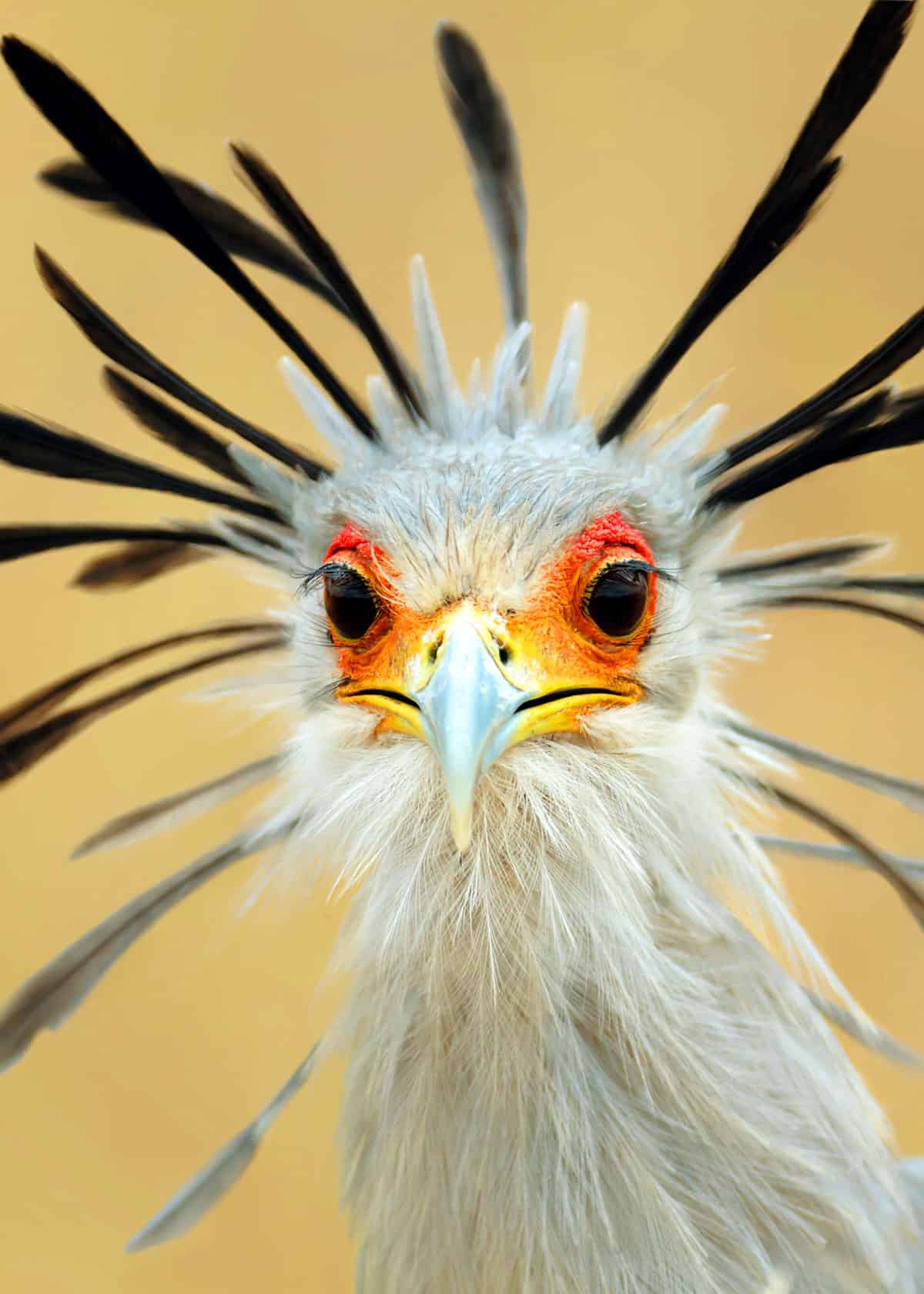
Topping off this spiffy suit are the long, dark plumes sticking out behind the bird’s head. This interesting bird even looks like it’s wearing makeup and false eyelashes with its yellowish-red facial skin.
Don’t expect the secretary bird to answer phones because its skills include hunting small mammals and stomping on snakes with its long crane-like legs in the grasslands and savannah of sub-Saharan Africa.
While this bird of prey is related to vultures, hawks, kites, and buzzards, it prefers to stand out from its cousins by spending most of its time on the ground (even though it can fly) and eating its prey right away rather than carrying it with its feet. At night, it roosts high in the acacia trees.
Secretary birds are monogamous and practice courtship dances through ascending and descending flight patterns as well as chasing and calling out to one another.
Both parents will feed their two to three chicks.
10. Resplendent Quetzal
- Latin name: Pharomachrus mocinno
- Unique colorful feature: Metallic green and blue plumage with a red chest
- Where they are found: Central America
- Size: Length: 14 to 16 inches (36 to 40.5 cm); Weight: 6.5 to 8 ounces (180 to 225 g)
- Diet: Fruits and occasionally insects
One of my personal favorites on this list of most beautiful birds, the resplendent quetzal was once held sacred by the Mayan and Aztec peoples who used the bird’s brilliant feathers in the headdresses of rulers and priests.
They didn’t believe in killing the bird but released it after removing its glorious tail feathers.
If you want to see this spectacular bird in its natural habitat, you’ll need to head to tropical Central America.
If you arrange an ecotour in Costa Rica, guides can take you into the cloud forest and provide you with a better opportunity to spot this beauty.
This quetzal is easily recognized by its crimson underparts and shimmering metallic green head, chest, back, and wings. The iridescent green feathers sometimes appear blue in the shade. A short, spiky green crest tops its crown.
The most resplendent feature of this gorgeous bird is the long, flowing train of blue-green feathers that the male grows just before mating season.
He uses this ornament to attract the female which is less striking in appearance with her bronze head, gray underparts, and green back and wings.
During courtship rituals, the male displays in flight patterns by ascending and descending while vocalizing.
Once the female accepts the male, the seasonally monogamous pair will build a nest in a tree cavity and alternate caring for their clutch of two eggs.
11. Red Crested Turaco
- Latin name: Tauraco erythrolophus
- Unique beautiful feature: Red crest
- Where they are found: The Congo, Republic of Angola
- Size: Length: 17.5 to 19.5 inches (45 to 50 cm); Weight: 7.4 to 11.46 ounces (210 to 325 g)
- Diet: Fruit, flowers, seeds, termites, and snails
If you’re on an African safari in Angola or the Congo and hear what sounds like monkeys chattering in the treetops, take a careful look because the sound may be coming from a family of red-crested turacos.
You can spot them by their tall, strawberry-red crests. These beautiful birds often flock together in groups of around 30 and prefer to hang out in the forest trees, eating fruits and insects, but will occasionally come down to the ground to bathe and drink water.
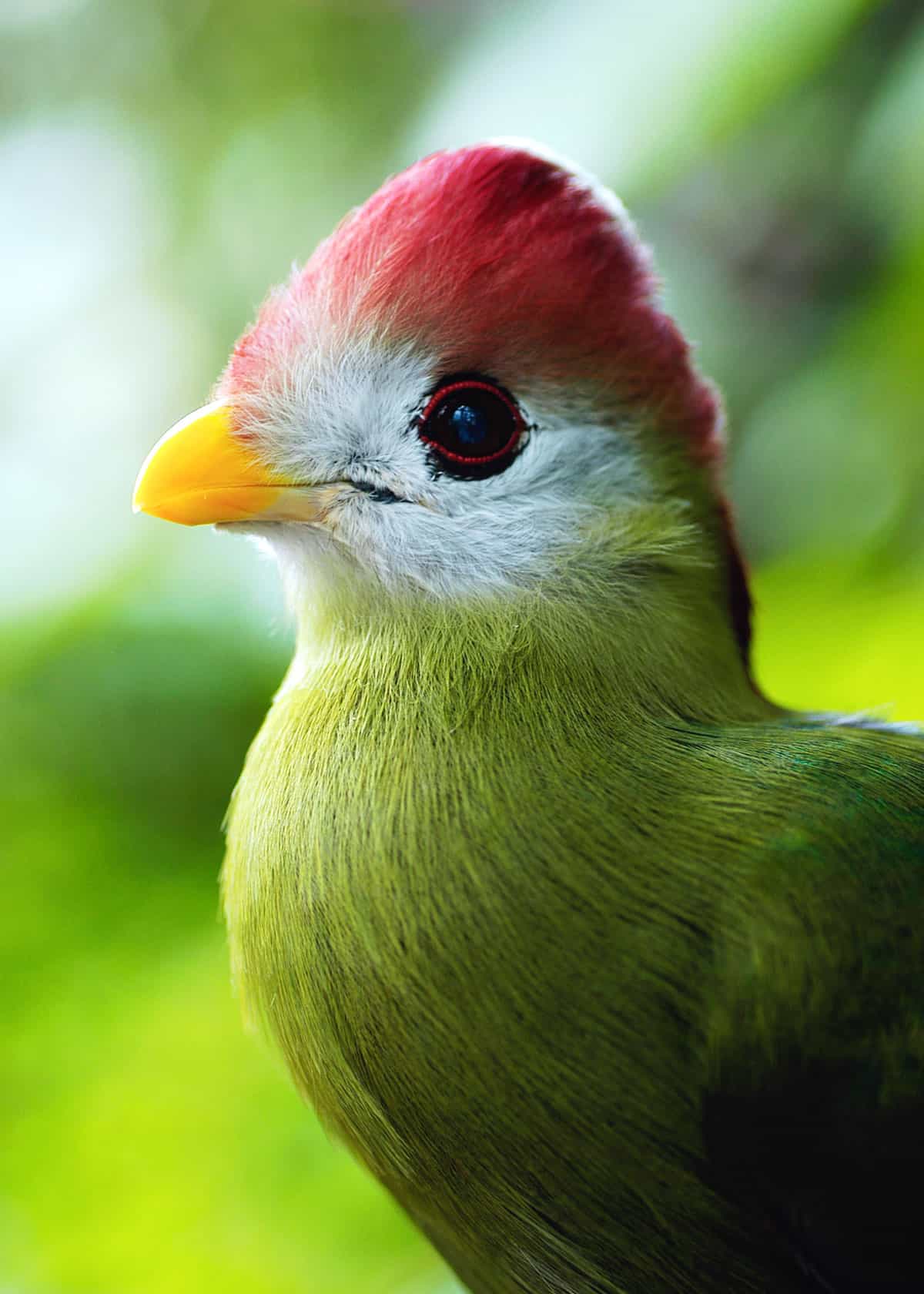
Both males and females look similar with overall green plumage, but the back and wings are more blue-green with side patches of red while the breast is olive-green, and the long tail is blue.
The face is white with a yellow beak and red eyes that match the red crest which rises up to two inches when the bird is excited.
Did you know that if you stir a cup of water with a feather from a red-crested turaco, the water will turn pink? The reason for this is that the pigment in this bird’s feathers contains copper.
Incidentally, this makes the turaco the only bird to possess a true green and red color rather than a reflection of color like most other species.
This species is monogamous, and during the breeding season, the male courts the female by feeding her and spreading his wings to showcase his crimson underparts.
Both males and females will take turns incubating their clutch of two to three eggs. After the chicks hatch, other family members will pitch in to help raise them.
12. Marvelous Spatuletail
- Latin name: Loddigesia mirabilis
- Unique beautiful feature: Violet, racquet-shaped tail feathers
- Where they are found: Río Utcubamba region of Peru
- Size: Length: 6 to 6.69 inches including tail (15 to 17 cm): Weight: 0.105 ounces (3 g)
- Diet: Nectar
After observing a male marvelous spatuletail, it’s easy to see how fairy myths were created. Zipping through the air faster than your human eyes can keep up with, this tiny hummingbird has shimmering multi-colors and striking tail feathers hovering on each side.
Found only within a small range of the forested mountains of the Río Utcubamba region in northwest Peru, this hummingbird features a bronze-green back and wings, a glittering turquoise throat, a violet-blue crest, and a buff underbelly that is divided by a long, black line.
The female shares the same bronze-green colors of the male but lacks the colorful head, throat, and tail.
As if the male marvelous spatuletail needed any further adornments, this bird’s most notable feature is a remarkable tail which consists of four feathers.
Two of these feathers are narrow, long, and straight, but the outer two feathers extend up to four times the bird’s body and end in two blue, racquet-shaped discs, known as spatules.
During mating season, the polygamous male uses his extraordinary tail feathers to attract a female by waving them around as he hovers in front of her. After choosing a male and mating, the female will raise her two chicks alone.
Spatuletail photos courtesy of the Internet Bird Collection
13. Hoopoe
- Latin name: Upupa epops
- Unique beautiful feature: Elegant crown of feathers
- Where they are found: Africa, Europe, Asia
- Size: Length: 10 to 11 inches (26 to 28 cm); Weight: 1.66 to 3.06 ounces (47 to 87 g); Wingspan: 16.5 to 18 inches (42 to 46 cm)
- Diet: Insects, seeds, berries, frogs, small reptiles
The hoopoe has a long, pointy crest with black markings. When the hoopoe is excited, the crest rises and spreads out like an elaborate headdress.
The black-and-white barred pattern of the back, wings, and tail look as if he is wearing a robe. His fawn-colored chest, neck, and face perk up tall and proud while his long, pointed beak gives him the appearance of wisdom.

Appearing often in open grasslands and woodlands as well as reserves and public gardens and parklands across Asia, Africa, and Europe, the hoopoe is a delight to see.
If you don’t spot it at first, you may hear its distinctive “hoop-hoop” call. If the sight of the hoopoe fills you with awe, you are not alone.
Not only is it the national bird of Israel, but even the ancient Egyptians regarded it as sacred by illustrating it on temples and tombs.
During the breeding season, hoopoes are monogamous and highly territorial. Males stay active during this period between serenading the female and beak-dueling with other males.
The female, who looks similar to the male but with duller colors, bears the sole responsibility of incubating her clutch of five to nine eggs.
While she is incubating and raising her chicks, the female has glands that secrete a stinking scent that is believed to put off predators. That’s a pretty clever trick!
14. King of Saxony Bird-of-Paradise
- Latin name: Pteridophora alberti
- Unique beautiful feature: Silvery-blue head plumes
- Where they are found: New Guinea
- Size: Length: 8 inches (22 cm); Weight: 2.82 to 3.35 ounces (80 to 95 g)
- Diet: Fruits, berries, and arthropods
The King of Saxony bird-of-paradise is one of those unique creatures you have to see to believe. If you wish to see one in their natural habitat, you’ll need to plan a trip to the rainforests of New Guinea.
The male’s blue-green gape, yellow underparts, and black wings, tail, and head all create a lovely vision that places it among the world’s most beautiful birds.
But, what really makes this bird so extraordinary is the set of two silvery-blue head plumes that can grow twice as long as the body length.
The male uses these jewels of his to attract the unadorned, grayish-brown female during courtship displays by wagging his head so that the plumes swirl around her.
Males of this species are polygamous and perform courtship displays in a lek. After accepting a male and mating, females will go off and raise a single chick on their own.
15. Barn Owl
- Latin name: Tyto alba
- Unique beautiful feature: White, heart-shaped face and chest
- Where they are found: Every continent except Antarctica
- Size: Length: 13 to 15 inches (33 to 39 cm); Weight: 7.9 to 25 ounces (224 to 710 g); ; Wingspan: 31 to 37 inches (80 to 95 cm)
- Diet: Mostly small rodents (mice, rats, shrews) but also rabbits, lizards, insects, birds, and bats
It may not be as colorful as some of the other species on this beautiful birds list, but the barn owl is no less stunning with its white heart-shaped face, creamy white underparts, and a golden back, wings, and tail that are dotted with dark spots.
Found all over the globe except in extreme hot and cold locations such as deserts and Antarctica, the barn owl is so-called because it loves roosting in old barns and abandoned buildings during the day.
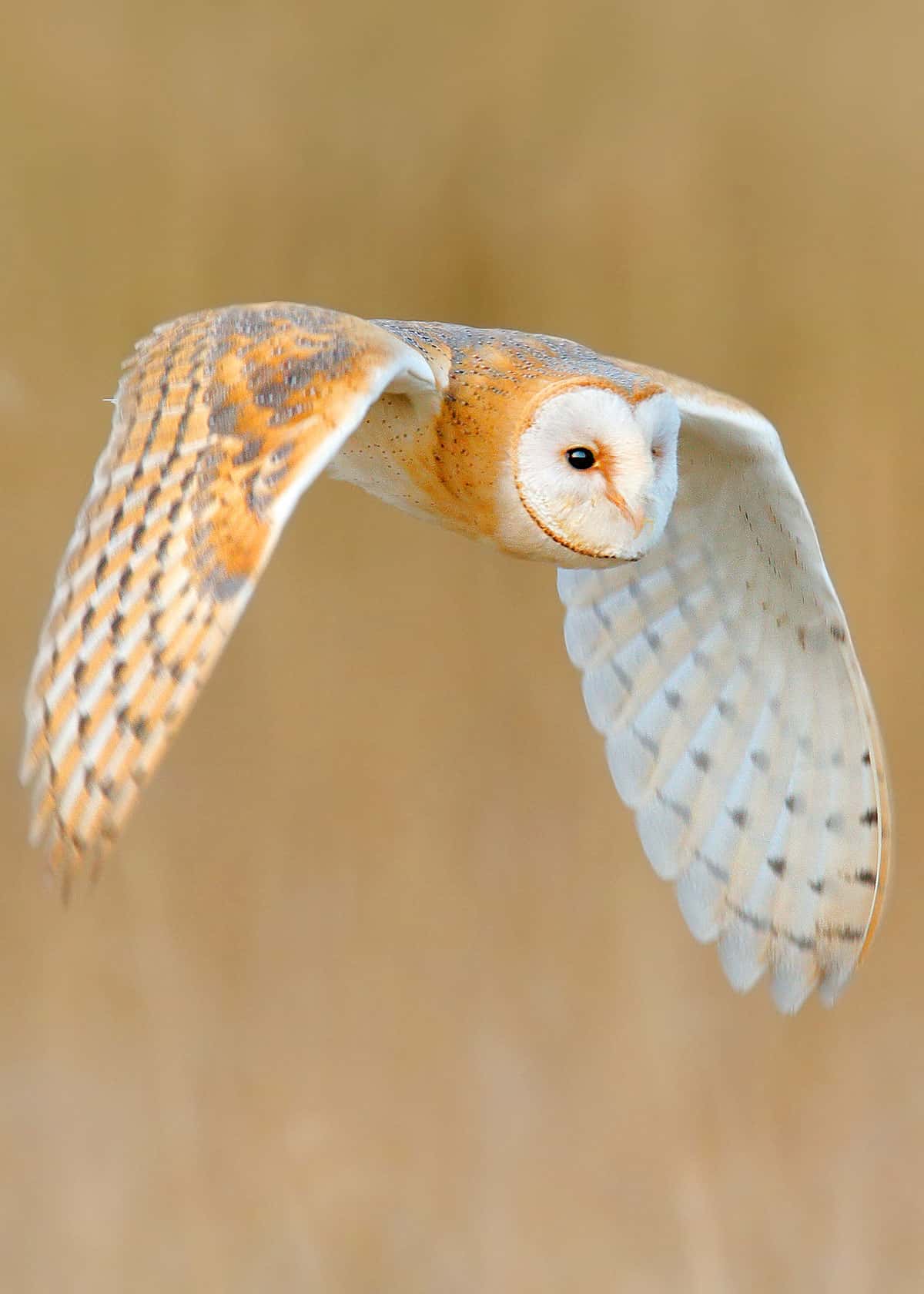
This nocturnal bird pierces the night with its eerie screech while hunting in open fields for its prey which often consists of rodents and rabbits but also lizards and insects as well.
Interestingly enough, these birds eat their prey whole, fur, and bones all. However, they later cough up the indigestible parts in pellet form.
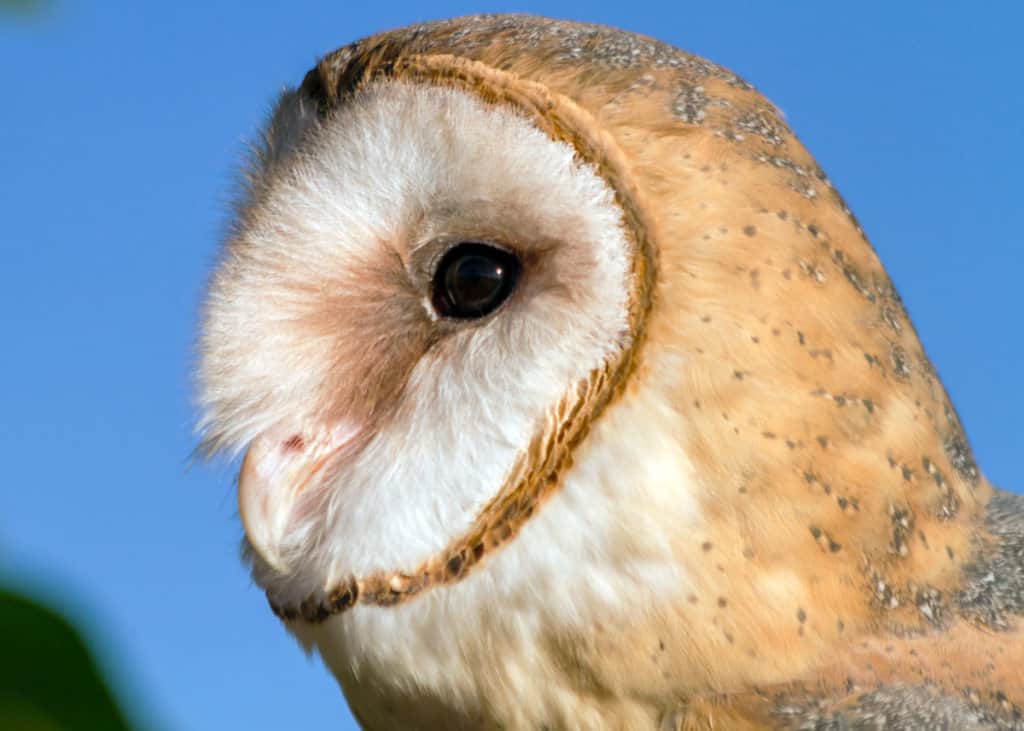
This species is different than all the others on this list because it’s the female, rather than the male, that boasts a showier appearance. Compared to her golden-winged counterpart, the female barn owl features deeper, reddish-brown plumage and a more densely spotted chest.
Barn owls are monogamous and usually mate for life until one of the pair dies.
During the breeding season, the male establishes a nesting spot. Afterward, he and the female will perform courtship rituals of flight displays and chasing one another.
The male also feeds the female during this time. Nests are built of regurgitated pellets in the cavities of trees, cliffs, or buildings. The male hunts down the food for the average clutch of five chicks, but the female distributes it to her young.
Natural Beauties
There are so many beautiful birds in the world, but not enough time to talk about them all which is why we focused on these fifteen species.
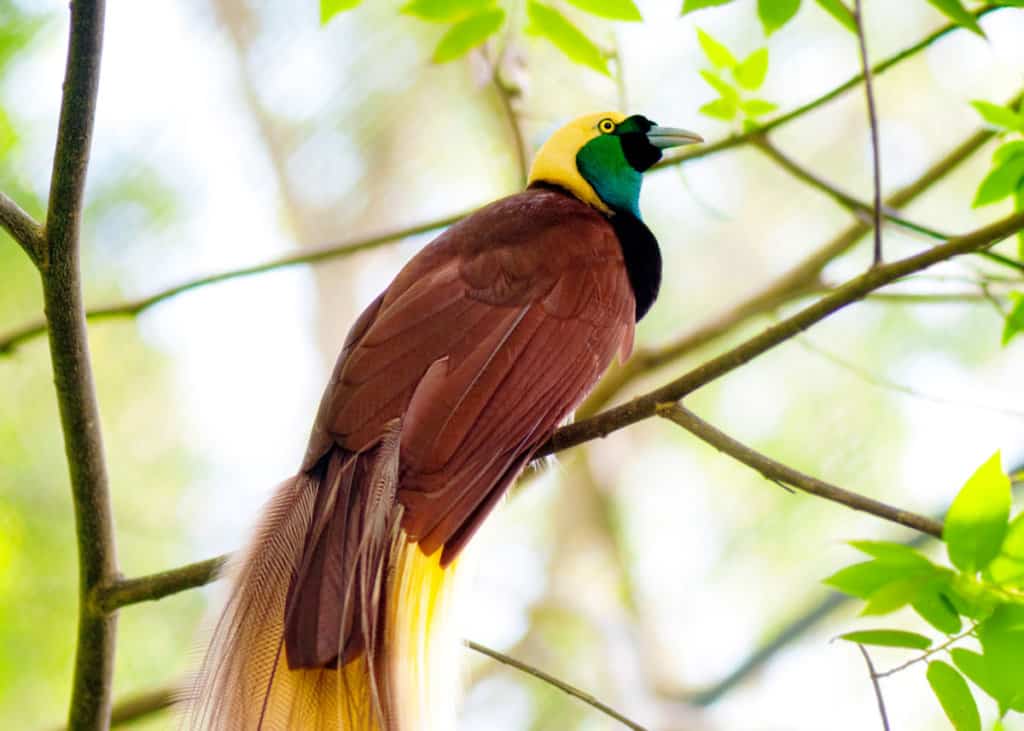
Are there any here that you were surprised to learn about? Are there any species that you feel should be added to this list? We would love to hear from you in the comments below!
Drew Haines is an animal enthusiast and travel writer. She loves to share her passion through her writing.
She graduated high school at sixteen and started her own business, Everywhere Wild Media. And she runs Everywhere Wild and JustBirding. She also guest blogs on Storyteller.Travel
She lived in Ecuador for 6 years and explored the Galapagos Islands. Currently based in N.S., Canada.




